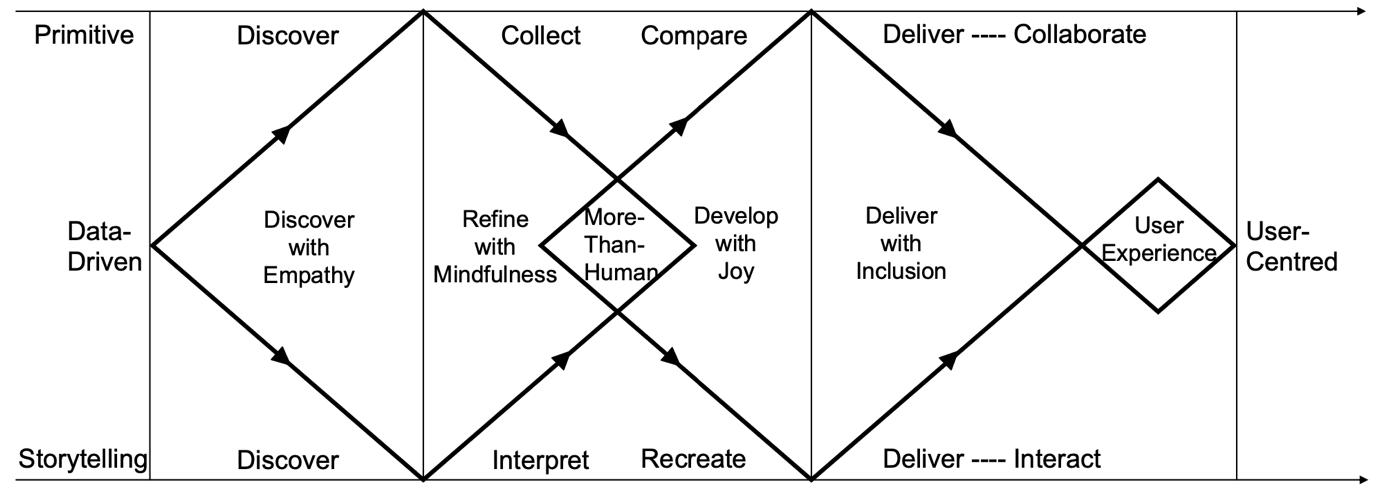
Introduction
This study presents a brief reflection on digital humanities with intellectual design and digital storytelling to support curation that augments scholarly practise. From “big tent” to “trading zone” (Svensson 2012: 36), digital humanities is a diverse and evolving field that advances humanities research through the application of technology, media, and computational methods, and broadly involves sustained interdisciplinary collaborations and in-depth interactions with digital processes and resources (Svensson 2010). In this context, design and digital storytelling are uniquely positioned and relevant within the field of digital humanities.
Intellectual design for scholarly thinking
Design thinking (also known as human-centred design) is innovatively applied as a methodology, a process, a framework and a practise in business, education, healthcare and cultural heritage organisations (Mason 2022). Design goes beyond mere visual aesthetics to play a central role in the conceptualisation and production of knowledge, shaping it and endowing it with form (Burdick et al. 2012: 117-118; Drucker 2020: 12-14), rather than being limited to the visual aesthetic aspects of interface design (Liu 2013). Design reaches all aspects of project design, database design, metadata schemes, information architecture, and interaction design for digital humanities practise, as well as the innovative construction of narratives and arguments in multiple media (Burdick et al. 2012: 118). Moreover, the Research Through Design method is increasingly being applied to digital humanities research (e.g., Kräutli / Boyd Davis 2016; Vane 2020). However, design is more often discussed as a critical or material method (Schofield et al. 2017), and its use as an intellectual thinking of knowledge production in digital humanities remains lacking in attention (Liu 2013).
Digital storytelling as a scholarly methodology
Digital storytelling, as an emerging method supported by digital technologies and media, can represent knowledge beyond time and space, offering new ways of interpreting and experiencing knowledge (Manovich 2002: 134-137), encouraging and facilitating the reconstruction of cultural memory (Fu et al. 2023). The characteristics of digital storytelling, such as interactivity, non-linearity, user participation, and co-creation (Barber 2016), enrich the practise of digital humanities by fostering collaborative curation and enabling interactive experiences, making it an essential scholarly approach in digital humanities research. While design and digital storytelling show great potential in both theory and practise (Boyd Davis et al. 2016), there is still a relative lack of comprehensive research on them in digital humanities.
Digital humanities curation model
Scholarly primitives structure and conceptualise aspects of scholarship in an abstract but generic way, and can provide a basis for more specific representations, becoming a valuable and accepted means (Hennicke et al. 2017). Scholarly primitives have been widely discussed and revisited (John Unsworth 2000; Andrez Pacheco 2022). The concept can be seen as a marketplace or 'trading zone' (Galison 1997), where scholarly research becomes products and services to be communicated and discussed (Blanke / Hedges 2013). Therefore, we choose the term scholarly primitives to describe the interdisciplinary research activities that are dominated by the digital humanities. This study focuses on how the interplay of intellectual design and digital storytelling with scholarly primitives can enhance knowledge production, representation, and dissemination, thus collectively contributing to the further development of digital humanities curation. We analyse different activities in intellectual design, digital storytelling, and scholarly primitives to propose a fishbone model for digital humanities curation.

Figure1. A Fishbone Model for Digital Humanities Curation
Within the digital humanities, intellectual design and digital storytelling are closely linked to scholarly practise, and they guide a process of knowledge curation that is both data-driven and human-centred. The model (Figure 1) is based on an innovative modification of the Double Diamond design model. The intersection in the middle emphasises the use of technologies such as big data, digital media, and artificial intelligence. The far-right side adds a user experience component as an extension. The top reflects the five digital humanities scholarly primitives. The bottom corresponds to the five key activities of digital storytelling. The middle section illustrates the stages of the Double Diamond design model with corresponding attributes to integrate the three dimensions. Although some of the activities have the same name, they all represent different meanings and form a practical path for digital humanities curation.
We are currently validating the proposed model through a case of data-driven visualisations and human-centred interactive digital storytelling in virtual reality environment to represent the journeys of displaced Chinese cultural objects. It is an iteration that builds on our previous work on China in Overseas Museums developed using Linked Data, Knowledge Graph, IIIF and other techniques.
Acknowledgement
We thank for the funding of this research by the Major Project “Resources Development and Service of Cultural Heritage Smart Data” (Grant No. 21&ZD334) supported by the National Social Science Foundation of China, the National Key Research and Development Program “Research and Development of Key Technologies and Platforms for Digital Services of National Archives of Publications and Culture Collection Resources (Typical Application Demonstration)” (Grant No. 2022YFF0901902) supported by the Ministry of Science and Technology of China, State Scholarship Fund (Grant ID: 202306270146) supported by China Scholarship Council, and the Youth Project "Research on the Integration of Linked Data and Narrative Presentation of Cultural Heritage Image Resources" (Grant No. 21CTQ041) supported by the National Social Science Foundation of China.